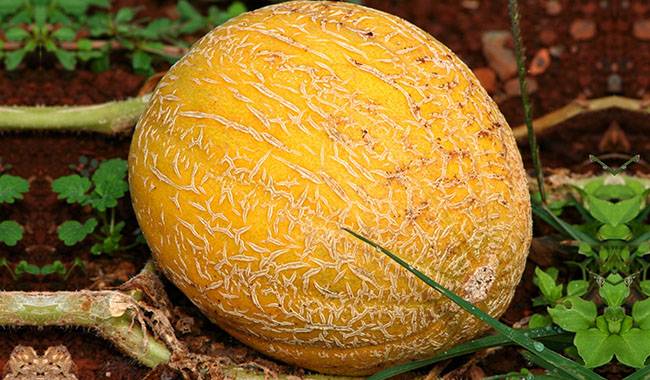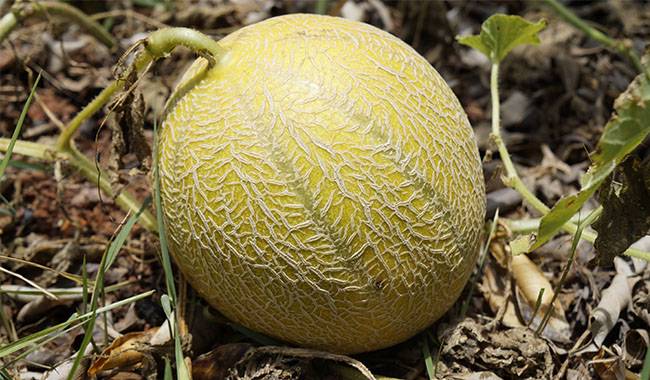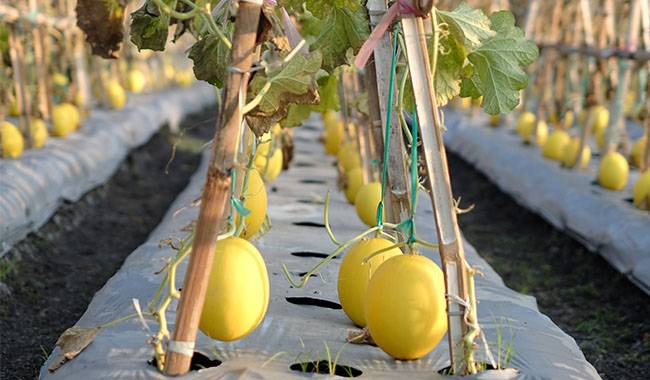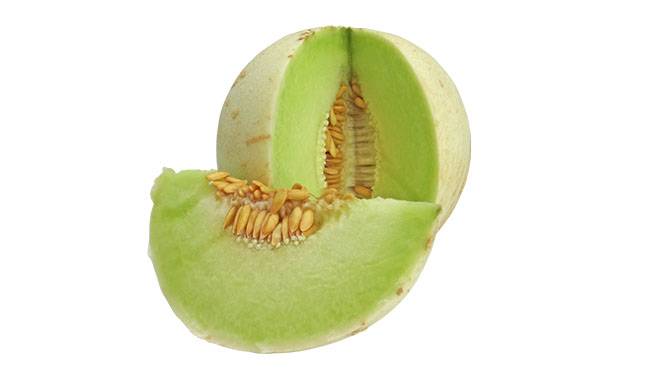
The slightly intoxicating scent of South Asian Beauty is reminiscent of the hot sun, whose rays (as legend has it) transform yellow sand into mysterious squash. The crop belongs to the pumpkin family. It is native to the subtropical and tropical regions of Asia. Muskmelon is a long-branched plant. Its leaves are large, hairy, and covered with short hairs. The flowers are solitary, yellow, and radiant. It is a drought-tolerant plant with a well-developed root system that can extract water deep into the soil. Learn in this article how to growing muskmelon by raising seedlings and sowing them in the open ground.
MUSKMELON VARIETIES FOR OPEN SPACES
Orange-Fleshed
Ambrosia (86 days to harvest, very sweet flesh)
Burpee Hybrid (85 days; standard oriental sutured melon)
Bush Star (88 days; 2 lbs; space-limited bush-type plant)
Earlisweet (68 days; very early; 2 to 3 lbs, good sweetness, firm flesh)
Gold Star (87 days; blight resistant)
Harper Hybrid (86 days, resistant to Streptomyces, wilt, mosaic)
Harvest Queen (OP-90 days, blight-resistant)
Iroquois (OP-85 days, Fusarium resistance, delicious)
Pulsar (80 days; heavy netting; resistant to powdery mildew, fusarium)
Rising Star (84 days; resistant to Fusarium 2)
Saticoy (86 days; resistant to wilt, powdery mildew)
Supermarket (88 days; blight and powdery mildew resistant)
Superstar (86 days; Fusarium 2 resistance; large; good flavor)
Green-Fleshed
Jenny Lind (OP-75 days, heirloom; medium to small, flattened squash with protruding blossom ends; sweet flesh)
Passport (73 days; tender flesh)
Rocky Sweet (80 days; thick, green, sweet flesh)
Sweet Dream (79 days; delicious, sweet, tasty)
Hybrid Honeydew-Type
Early Dew (85 days; creamy yellow skin, good flavor)
Honey Brew (90 days; high yielding; strong, disease-resistant vines)
Limelight (96 days; 7 to 8 lbs; thick, juicy, sweet flesh)
Morning Dew (96 days; largest honeydew type; 10 to 12 pounds; thick, sweet flesh)
Morning Ice (84 days; powdery mildew resistant, Fusarium minor 2)
Venus (88 days; smooth golden yellow skin with a thin web; thick, juicy, aromatic flesh)
Other Specialty Melons
Casaba Golden Beauty (OP-110 days; 7 to 8 lbs; white, spicy-sweet flesh)
Early Crenshaw (90 days)
Honeyshaw (85 days; ground salmon meat, tasty)
Marygold (92 days; casaba type; yellow, wrinkled skin, white flesh)
Note: All varieties are hybrids unless OP (for open pollination) is specified.
All of the above muskmelon varieties produce 3.3-4.4 Lb (1.5-2 kg) of fruit. Several varieties can be used to form a variety conveyor belt. Breeders offer other excellent varieties and hybrids. The above-mentioned varieties are an example of creating a conveyor belt.
WHERE TO GROW MUSKMELON?
Given its southwestern origin – California – the crop should be placed in a well-lit and wind-free location. On open plots, muskmelon can be protected from prevailing winds by “bushes” of sunflower, sorghum, or corn. In crop rotation, the best predecessors are onions, garlic, tomatoes, spice crops, beans, peas, cabbage, eggplant, bell peppers. Muskmelon should not be planted in the same place for several years after squash, carrots.
SOIL PREPARATION
muskmelon needs light soil that is permeable to wind and water, preferably loamy sandy soil. Dry, slightly salty soil can be used for growing muskmelon. The crop does not tolerate thick swampy areas. Stimulating irrigation for weed sprouting after harvest predecessors, elimination of weeds by deep replanting, no on black calcium soils can be done by turning the ground, on turf and other soils do not need to be turned. Compost or humus should be spread on half a bucket with 200-250 grams of ash per 11 square feet.
If an area has not been fertilized with organic matter for a long time and only mineral fertilizers are used, it can become very acidic. Lime should be used in these areas. Sprinkle 300 grams of lime on sandy and sandy loam soils and 400 grams of lime on loamy soils and incorporate them into a 4inch (10 cm) layer. When the topsoil matures in 4-6inch (10-15 cm) and warms to 53-57°F (12-14°C), apply 70-80 g of nitroglycerin/11 sq ft. Prior to sowing muskmelon or sowing seedlings, the field is tilled with 10-20 g/11 ft2 of nitrogen fertilizer.
SEED PREPARATION AND SOWING OF MUSKMELON
Seeds that are 3 to 4 years old should be used for sowing. If sowing with fresh seeds, you may not get female plants, only males. muskmelon seeds should be disinfected with a manganese solution (half an hour) or other preparation before sowing. Be sure to wash them in clean, warm water.
In the south, muskmelon seeds are sewn into the soil at the end of April or the beginning of May. For early sowing (end of April), the seeds are sown dry, while in May, they are sown in heaps. The holes for sowing are placed in rows at 28-30inch (70-80cm) intervals and 40-60inch (1-1.5m) between rows, depending on the variety of succulents. Sow 3 to 5 seeds in a 2-2.3inch (5-6 cm) moist hole. Due to the short warm period, muskmelon is grown by seedlings in the central United States.
PLANTING MUSKMELON SEEDLINGS
In early May, muskmelon seeds were sown in different containers. They are transferred to the field in early June. A standard seedling (25-30 days) has 3-5 leaves. It is better to prepare the clearing by combing and preparing the seedlings for planting on the ridge. Pots (peat, paper, or other) are filled with a light soil mixture. Moisten the mixture and sow 2-3 squash seeds separately. Place the pots on a common tray at 68-71°F (20-22°C). After germination, leave the strongest buds in the pots and carefully pull off the rest (preferably at the soil level).
The first watering should be done when the first leaves are formed. Water finely under the roots so as not to wet the stems and leaves. Water systematically so that the top layer of soil does not dry out. Prune muskmelon after the third pair of leaves has formed. This method promotes the formation of lateral branches. Under irrigation, fertilize the seedlings with a compound fertilizer (nitrate fertilizer can be used) twice every 2 weeks. Seedlings should be hardened for a week before planting.
PLANTING MUSKMELON MELON SEEDLINGS IN A SEEDBED

The pots with muskmelon seedlings are watered so that the plants can be extracted without disturbing the roots. In the prepared soil, holes are made in the ridge according to the chosen scheme. 10-15 g of nitroglycerin is applied and moistened. Transfer the shrub to the center of the hole and cover it with soil up to the root neck so that it is at the soil level. For the first 2-3 days, the seedlings should be protected from sunlight.
OPEN-AIR MUSKMELON CARE
Further care of the culture, sowing and planting of the seedlings is almost identical and consists at least of loosening the soil, which is carried out in the first month only up to the closing of the rows, reaching 6inch (15 cm) and then decreasing to 4inch (10 cm). The soil was loosened only between the rows. During the lateral circulation phase, the melons are gently soaked. When the leaves are close, no-tillage is done.
Fertilization of melons
Generally, two to three fertilizer applications are made before leaf closure (to prevent fruit spoilage). The first feeding with growth stimulants, ammonium nitrate, and other related fertilizers should be done one week after mass germination. During the germination stage, organic fertilizer feeding is carried out at a dilution ratio of 1:10-15. the last fertilizer application is made simultaneously with the growth of muskmelon ovaries (about 3 weeks after the last application). A solution of 50 and 20 g of phosphorus and potassium fertilizer was applied in a bucket of warm water.
Pinching of melon seeds
To obtain good yields, it is necessary to limit the development of asexual reproduction in the bush. This is achieved by pruning the shoots. For varieties, the main branches are pruned repeatedly, leaving 2-3 lateral branches. For hybrids, the main branches are not picked since the female flowers are located above, while the lateral branches are picked at the second pair of leaves. Cultivation of large-fruited muskmelon requires the removal of some fruiting ovaries. Depending on the growth of the stalk, two to six ovaries should be left per plant. Use roofing felt sheets or other materials as a substrate to prevent fruit rot.
Watering muskmelon
Muskmelon plants do not tolerate high humidity, so water with 1-2inch (2.5-5 cm) or 2-2.3inch (5-6 cm) of warm water 68-77°F (20-25°). Do not use sprinkler irrigation, only by irrigation ditches. As oviposition approaches, the rate of watering should be reduced and stopped completely at maturity. This practice will allow muskmelon to accumulate more sugar. If irrigation exceeds the allowed level, the fruit will turn sour, many fruits will rot at the roots, and the root system will be affected by fungal diseases.
PROTECTING MUSKMELON FROM PESTS AND DISEASES
Under humid conditions, the roots and above-ground parts of the muskmelon plant quickly become infected with fungal diseases (powdery mildew, anthracnose, fusarium, pearl fungus, etc.). Protective and curative measures can be carried out only with biological agents, according to the recommendations of Phytosporin, Allylene, Gamal, Mycorrhizal, Planriz, and others.
Aphids, moths, spider mites, and wireworms cause significant damage to muskmelon. Only biological agents can be used for protection. The most common biopesticides are Bitoxybacillin (a biopesticide) and others, used against gnawers, against suckers-myclobutanil, vitamins. The waiting time varies from 1 to 4-5 days. Thus, the biological drug “Planriz-bio” can be used the day before harvesting.
HARVESTING MUSKMELON
Muskmelon is harvested when the fruits are ripe. The preparation for harvesting can be judged by the ease of separation of the fruit from the stalk, the bright color of the skin, and the fine network of cracks covering the skin. A dense network of fine cracks covers fruits that should be used immediately for food and processing.
Fruits with few cracks or only a few cracks on the peel can be stored for up to 6 months. The ripeness of unpeeled fruit is indicated by the strong aroma and the ease of separation from the stalk.
More related information about growing muskmelon plants





